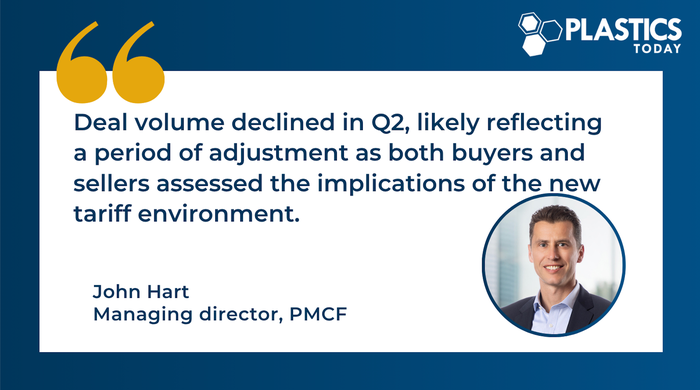Plastics Industry M&A Surges in 2025, Despite Tariff Uncertainties

At a Glance
- Amcor-Berry merger reshapes plastics industry with $10.5 billion deal.
- Flexible packaging has seen the most consolidation in the first half of 2025.
- ESG considerations increasingly drive plastics acquisition valuations higher.
The plastics industry has witnessed robust merger and acquisition activity during the first half of 2025, with deal volume maintaining strong momentum from the start of the year.
The Amcor-Berry Global merger represents one of the largest transactions in the industry's history. The shadow of that $10.5 billion deal has loomed large over other M&A activity in the sector during H1 2025, and it has had a ripple effect throughout the plastics industry.
Trevor Hulett, managing director of St. Louis, MO–based investment bank R.L. Hulett and Company Inc., said his company is expecting an uptick in activity following the Amcor-Berry Global merger, which significantly expanded Amcor's packaging capabilities across both product lines and geographic markets.
"The scale and synergies unlocked by the Amcor-Berry transaction have set a new benchmark, prompting other large players to reevaluate their own portfolios and pursue acquisitions that strengthen core offerings, improve supply chain resilience, and accelerate sustainable packaging initiatives," he said.
John Hart, managing director at PMCF, an investment bank providing merger and acquisition services to companies worldwide, told PlasticsToday that prior to 2024, the plastics manufacturing industry experienced several years of relative stability, with limited major consolidation activity among top players.
Related:Plasan North America Cuts 64 Jobs Following Government Contract Cancellation
"However, 2024 marked a turning point, with a wave of significant mergers and acquisitions reshaping the competitive landscape," he said. "Notable recent transactions include the Amcor-Berry merger, Novolex's acquisition of Pactiv Evergreen, SIG's purchase of Schoeller Allibert, IPL's merger with Schoeller Allibert, Silgan's acquisition of Weener, and Sonoco's divestiture of its thermoforming business. These deals signal a renewed momentum in strategic consolidation across the sector."
According to Hart, this trend has two key implications for the M&A market:
-
Opportunities for middle-market players. As large companies consolidate, they often become less agile and may outgrow their traditional middle-market customer base. This creates opportunities for smaller and mid-sized businesses to increase wallet share and capture market share by offering more tailored and responsive solutions.
-
Portfolio rationalization. Large-scale consolidations typically lead to plant closures and business unit divestitures as companies streamline operations. While we haven't seen significant rationalization yet, it is likely that over the next few years, these newly formed platforms will begin optimizing their portfolios — creating acquisition opportunities for strategic and financial buyers.
Related:Röhm Shutters Louisiana Plant, Texas Mega-facility Launches
Hart also pointed out that capital invested in plastics M&A increased dramatically in Q1 2025 ($9.4B, up 193.8% from Q4 2024). There are several factors driving this surge in transaction values despite the slight decline in deal volume.

"Deal volume declined in Q2, likely reflecting a period of adjustment as both buyers and sellers assessed the implications of the new tariff environment," Hart added. "Despite this slowdown, larger transactions — particularly those with strong fundamentals and resilience to macroeconomic volatility — continue to move forward."
Moreover, Hart explained that the current market presents a compelling environment for transformational M&A. With significant capital still available and valuations at more attractive levels, strategic investors are well-positioned to pursue high-impact opportunities.
"We've seen significant activity in the Mid-Atlantic region and Canada during Q1," he said.
Hart added that while PMCF doesn't typically track deal activity by region, Q2 data revealed a notable concentration along the East Coast.
"Over half of all US-based transactions were completed in the Northeast and Southeast — consistent with historical M&A trends. Additionally, the Midwest reported a strong quarter, accounting for more than 25% of total Q2 deal volume, highlighting continued momentum in that region," he said.
Related:Dow Slashes European Operations Amid Profitability Push
Hulett said the Southeast US region saw an increase in M&A activity in Q2 with 9 transactions. Most notable in this region was Toppan's $1.8 billion acquisition of Sonoco.
Subsector activity
Hulett pointed out that flexible packaging has seen the most consolidation in the first half of 2025, as larger players continue acquiring competitors to gain scale, drive down costs, and expand their sustainable packaging capabilities.
"While segments like specialty materials and machinery have also experienced increased deal activity, they haven't matched the pace or volume seen in packaging so far this year," he said.
Hart noted that during H1, injection molding and resin/color & compounding have remained among the most active subsectors from an M&A perspective.
"Both are currently tracking above their H1 2024 deal volumes and are aligned with the pace observed in H2 2024," he said. "Drivers of activity in these subsectors are different. In injection molding, a highly fragmented area of the market with vast applications, deal volume is mainly driven by a robust supply of active sellers. On the resin/color & compounding side, a more concentrated market and active buyers has led to stronger multiples than in other subsectors, which may be the cause of increased activity."
Moreover, Hart noted that specialty transactions — which include deals in extrusion, machinery, composites, and distribution — have also seen a steady increase in recent years. The 89 deals recorded in H1 2025 exceeded H1 2024 levels, though they fell slightly short of H2 2024.
Nonetheless, Hart explained the sustained activity in specialty subsectors reflects a growing trend of consolidation in niche areas of the plastics industry, which continue to attract strong interest from both strategic and private equity buyers.
Hulett said his company saw capital investment moderate in Q2 to $2.2 billion, but H1 2025 was still up meaningfully over H1 of the prior year.
"Several large transactions in early 2025 helped open the floodgates for even bigger deals across the plastics industry," he said. "This increase in larger sized deals is driven by both strategic consolidations and private equity interest. Valuations have continued to climb, particularly in high-growth areas like sustainable packaging, where buyers are willing to pay a premium for long-term positioning and ESG alignment."
Cross-border transactions
There were several cross-border transactions in Q1, including Sudarshan Chemical's acquisition of Germany's Heubach. Hart noted that cross-border transactions in the plastics sector declined year-over-year in the first half of 2025, with only 19 deals recorded — down from 30 and 34 in the previous two halves, respectively.
"This slowdown may be attributed to ongoing uncertainty surrounding tariffs, as both buyers and sellers take time to assess the potential impact on their operations and deal structures," he said. "In contrast, domestic M&A activity has remained strong. A total of 82 domestic deals were announced in H1 2025, representing an increase of seven deals compared to H2 2024. While cross-border activity has slowed, it continues to play a role in the market, albeit at a reduced pace relative to prior periods."
Moreover, Hulett cautioned that global tariff uncertainty has led to more cautious deal structuring, with a noticeable rise in the use of earn-out provisions and more rigorous due diligence.
"At the same time, supply chain security has become a key focus in the first half of 2025, prompting many companies to strategically reposition operations and acquisitions in regions that offer greater stability and logistical efficiency," he said.
Trends driving M&A
Tom Blaige, chairman and CEO of Chicago, IL–based Blaige and Company, a plastics, packaging, and chemicals investment banking firm, noted that in 2024, 80% of all plastics deals were strategically motivated, including 55% strategic buyers and 25% financial add-ons.
Blaige also noted that 73% of all plastics M&A deals last year involved an international participant.
"International-only deals have increased from 40% of deals in 2001 to 57% in 2024, reflecting an ongoing trend toward globalization over the last two decades," the company noted in its report.
Plastics remains the most fragmented market, with 72% of companies posting annual sales under $50 million, and 82% posting sales under $100 million.
By the end of the year, Blaige forecasts that the top 50 companies in injection molding; blow molding; film and sheet; labels; pipe, profile and tubing; thermoforming; and adhesives and sealants will have been eliminated or changed ownership since 2001.
"M&A is 10% financial analysis, and 90% psychoanalysis," Blaige said.
It is key for companies poised to make a deal to have a succession plan in place; pursue niche leadership; have enough funding to double or triple down to stay competitive; focus on "glass half full" buyers who may view business as complementary; and understand that vertical, horizontal, and geographic integration trends could impact margins and growth.
ESG considerations and future outlook
Hart also noted that environmental, social, and governance (ESG) concerns remain a key topic of discussion among plastic packaging providers and continue to present growth opportunities for specialty material science companies.
"While ESG remains relevant, its influence has been somewhat tempered under the current administration," Hart said. "In non-packaging plastic subsectors, we continue to see limited viable alternatives to plastics, reinforcing the material's role in a range of industrial applications despite ongoing sustainability debates."
Hulett pointed out that ESG has taken on a larger role in plastics M&A, with buyers placing a premium on targets that demonstrate strong sustainability practices.
"It's no longer just a consideration, it's become a core value driver in how deals are evaluated, negotiated, and ultimately priced," he noted.
Based on H1 2025 activity, from an M&A perspective, Hart said he remains cautiously optimistic about the remainder of the year.
"While uncertainty — particularly around tariffs and macroeconomic policy — can dampen deal activity by increasing perceived risk, there is growing confidence that the second half of the year will bring greater clarity on trade policy," he said. "Additionally, market sentiment is buoyed by the possibility of interest rate cuts by the Federal Reserve, which would create a more favorable environment for transactions."
Hart cautioned that market conditions can shift quickly.
"However, based on our current positioning and the conversations we're having across the industry, the outlook appears positive," he explained. "Notably, we've seen a significant uptick in pre-deal activity, which we view as a strong leading indicator of continued momentum. In general, niche companies with domestic supply chains are likely to outperform, given their resilience to global disruptions. No single subsector stands out as a clear beneficiary; deal activity has remained relatively balanced across the industry year-over-year."
Within the broader plastics sector, Hulett said his company believes packaging as a subsector is expected to remain the most active segment for M&A in the second half of 2025, particularly in areas tied to scale, automation, and sustainability.
"Specialty materials, advanced machinery, and ESG-focused technologies are also likely to attract strong interest, with private equity continuing to pursue strategic acquisitions and platform growth across the sector," he concluded.
【Copyright and Disclaimer】This article is the property of PlastMatch. For business cooperation, media interviews, article reprints, or suggestions, please call the PlastMatch customer service hotline at +86-18030158354 or via email at service@zhuansushijie.com. The information and data provided by PlastMatch are for reference only and do not constitute direct advice for client decision-making. Any decisions made by clients based on such information and data, and all resulting direct or indirect losses and legal consequences, shall be borne by the clients themselves and are unrelated to PlastMatch. Unauthorized reprinting is strictly prohibited.
Most Popular
-

At Least 44 Dead in Century-Old Fire! Questioning Hong Kong's Hong Fu Garden: Why Has the Path to Fire Resistance Taken 15 Years Without Progress?
-

Satellite chemical's profits surge! can the 26.6 billion yuan high-end new materials project meet expectations? a review of progress on four major projects
-

Key Players: The 10 Most Critical Publicly Listed Companies in Solid-State Battery Raw Materials
-

Estun Turns Profitable in 2025 Half-Year Report, Industrial Robot Shipments Rank First Among Domestic Brands
-

Avatr Files for IPO on HKEX, Plans to Complete Listing in Q2 2026






